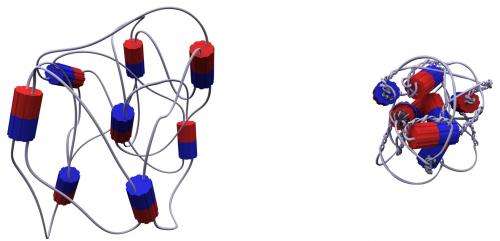A contractile gel that stores light energy

Living systems have the ability to produce collective molecular motions that have an effect at the macroscale, such as a muscle that contracts via the concerted action of protein motors. In order to reproduce this phenomenon, a team at CNRS's Institut Charles Sadron led by Nicolas Giuseppone, professor at the Université de Strasbourg, has made a polymer gel that is able to contract through the action of artificial molecular motors. When activated by light, these nanoscale motors twist the polymer chains in the gel, which as a result contracts by several centimeters. Another advantage is that the new material is able to store the light energy absorbed. This paper is published in Nature Nanotechnology dated 19 January 2015.
In biology, molecular motors are highly complex protein assemblies that can produce work by consuming energy: they take part in fundamental biological functions such as copying DNA and protein synthesis, and underlie all motion processes. Individually, these motors only operate over distances in the region of a nanometer. However, when millions of them join up they can work in a completely coordinated way, and their action can have an effect at the macroscale.
Chemists have sought for many decades to produce this type of motion using artificial motors. To achieve this, the researchers at Institut Charles Sadron replaced a gel's reticulation points, which cross-link the polymer chains to each other, by rotating molecular motors made up of two parts that can turn relative to each other when provided with energy. For the first time, they succeeded in getting the motors to work in a coordinated and continuous manner, right up to the macroscale: as soon as the motors are activated by light they twist the polymer chains in the gel, which makes it contract.
Just as in living systems, the motors consume energy in order to produce continuous motion. However, this light energy is not totally dissipated: it is turned into mechanical energy through the twisting of the polymer chains, and stored in the gel. If the material is exposed to light for a long time, the amount of energy contained in the contraction of the polymer chains becomes very high, and can even trigger a sudden rupture of the gel. The researchers at Institut Charles Sadron are therefore now attempting to take advantage of this new way of storing light energy, and reuse it in a controlled manner.
More information: "Macroscopic contraction of a gel induced by the integrated motion of light-driven molecular motors." Quan Li, Gad Fuks, Emilie Moulin, Mounir Maaloum, Michel Rawiso, Igor Kulic, Justin T. Foy, and Nicolas Giuseppone. Nature Nanotechnology, 2015, DOI: 10.1038/NNANO.2014.315
Journal information: Nature Nanotechnology
Provided by CNRS


















